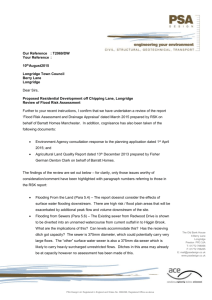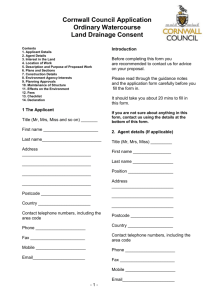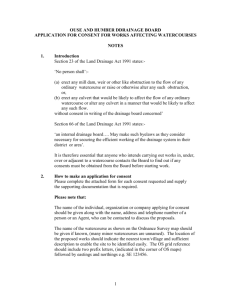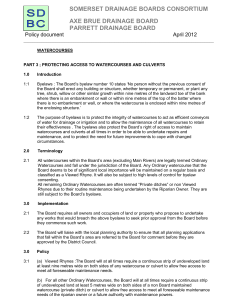Our Ref: - Somerset Drainage Boards Consortium
advertisement
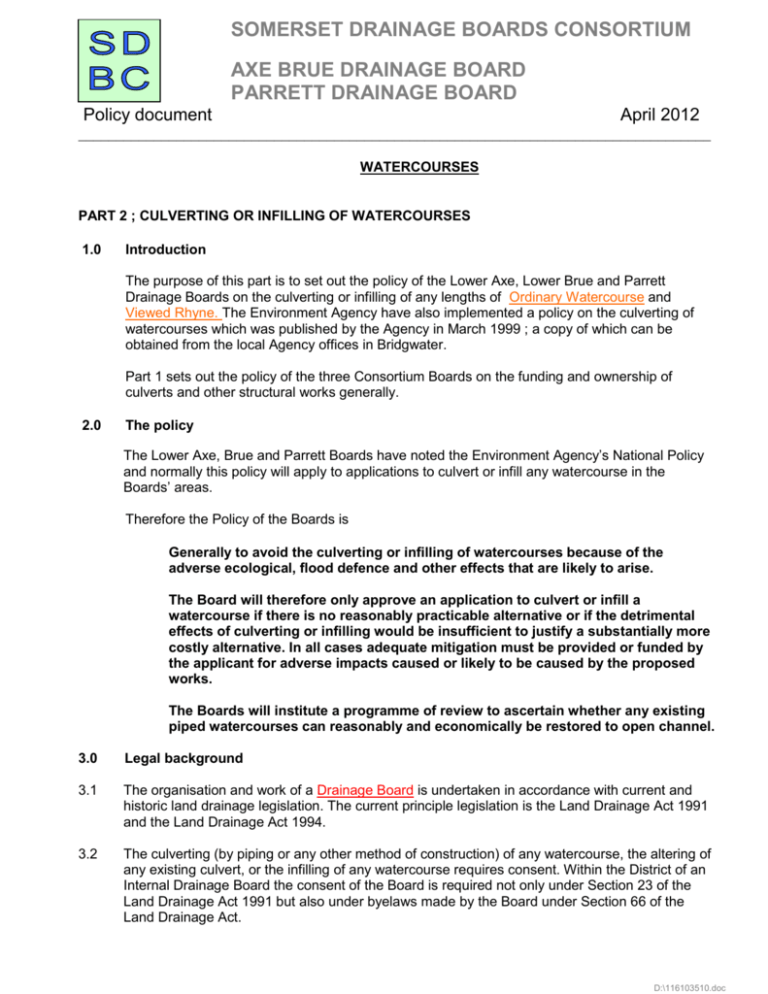
SOMERSET DRAINAGE BOARDS CONSORTIUM I AXE BRUE DRAINAGE BOARD PARRETT DRAINAGE BOARD Policy document April 2012 ____________________________________________________________________________________ WATERCOURSES PART 2 ; CULVERTING OR INFILLING OF WATERCOURSES 1.0 Introduction The purpose of this part is to set out the policy of the Lower Axe, Lower Brue and Parrett Drainage Boards on the culverting or infilling of any lengths of Ordinary Watercourse and Viewed Rhyne. The Environment Agency have also implemented a policy on the culverting of watercourses which was published by the Agency in March 1999 ; a copy of which can be obtained from the local Agency offices in Bridgwater. Part 1 sets out the policy of the three Consortium Boards on the funding and ownership of culverts and other structural works generally. 2.0 The policy The Lower Axe, Brue and Parrett Boards have noted the Environment Agency’s National Policy and normally this policy will apply to applications to culvert or infill any watercourse in the Boards’ areas. Therefore the Policy of the Boards is Generally to avoid the culverting or infilling of watercourses because of the adverse ecological, flood defence and other effects that are likely to arise. The Board will therefore only approve an application to culvert or infill a watercourse if there is no reasonably practicable alternative or if the detrimental effects of culverting or infilling would be insufficient to justify a substantially more costly alternative. In all cases adequate mitigation must be provided or funded by the applicant for adverse impacts caused or likely to be caused by the proposed works. The Boards will institute a programme of review to ascertain whether any existing piped watercourses can reasonably and economically be restored to open channel. 3.0 Legal background 3.1 The organisation and work of a Drainage Board is undertaken in accordance with current and historic land drainage legislation. The current principle legislation is the Land Drainage Act 1991 and the Land Drainage Act 1994. 3.2 The culverting (by piping or any other method of construction) of any watercourse, the altering of any existing culvert, or the infilling of any watercourse requires consent. Within the District of an Internal Drainage Board the consent of the Board is required not only under Section 23 of the Land Drainage Act 1991 but also under byelaws made by the Board under Section 66 of the Land Drainage Act. D:\116103510.doc SOMERSET DRAINAGE BOARDS CONSORTIUM I LOWER AXE DRAINAGE BOARD LOWER BRUE DRAINAGE BOARD PARRETT DRAINAGE BOARD Draft policy document ____________________________________________________________________________________ 3.3 The Land Drainage 1994 and The Wildlife and Countryside Act 1981 places both general and specific duties on an IDB relating to environmental and nature conservation matters and there is much other legislation having direct and indirect significance affecting an IDB’s exercise of its functions. There are also European directives in existence which an IDB must take note of as well as any regulations made by the UK government pursuant to those directives. 3.4 In determining any application for consent, the Lower Axe, Lower Brue or Parrett Drainage Board must have regard, not only for the wishes of the applicant, but of its own environmental duties and responsibilities under statute. 4.0 Reasons for the policy In addition to the issues raised in Section 2 the Boards are, in general, opposed to the culverting or infilling of watercourses within their Drainage Districts because of the detrimental effects that may subsequently arise. Such effects may be: Loss of and adverse effect on environmental features and wildlife habitats. Increased likelihood of localized flooding due to culvert blockage. Potential loss of floodwater storage capacity Increased maintenance liabilities, repair costs and possible ownership disputes Increased safety hazards in undertaking inspections and maintenance. 5.0 Application of the policy 5.1 Although the policy will apply to all proposals on all watercourses in the board’s District nonetheless, it is recognized that in certain situations the use of culverts may, in practice, be unavoidable. Such situations include health and safety, short length culverts for access purposes (as mentioned at greater length in part 1) or where highways cross watercourses. In such cases, the length should be restricted to the absolute minimum necessary to meet the applicant’s objective and, where appropriate, environmental enhancements included in the proposals. Where practicable, clear span bridges are normally preferred. 5.2 Applicants must demonstrate that they have considered alternatives to culverting, (including the cost), and show that appropriate facilities for future maintenance form part of the proposals. The applicant must state who will be legally responsible for future ownership and maintenance of the culvert, its headwalls, and the land surface above, bearing in mind that the Board's Byelaws forbid building and other activities without consent within a specified distance either side of the culvert. See Part 10 ‘Development adjacent to watercourses and culverts’ 5.3 Where the Board has knowledge of the presence of important or protected species an automatic refusal will result even though other flood risk criteria may be acceptable. In order for the proposal to be considered, full consultation, agreement and licensing with Defra and Natural England will be required. Evidence will need to be made available to the Board. 5.4 It is equally important that where watercourses are to remain open, an adequate width of undeveloped land is retained adjacent to the channel for maintenance purposes, for the deposition of dredged material and for the continuity of the natural environment and wildlife. SOMERSET DRAINAGE BOARDS CONSORTIUM I AXE BRUE DRAINAGE BOARD PARRETT DRAINAGE BOARD Policy document April 2012 ____________________________________________________________________________________ 5.5 Applicants should also be aware that Land Drainage Consents do not override an adjacent landowners’ rights nor do they permit interference with legally protected wildlife habitats. 6.0 Mitigation Works 6.1 Where it is demonstrated there there is no reasonable alternate to culverting or infilling then mitigation works for both hydraulic and environmental losses will be required. 6.2 The construction of a culvert within an existing watercourse will have a detrimental impact on both the flow capacity as well as the flood storage capacity of that watercourse. The provision of an adequately sized pipe or culvert will minimize the restrictions and ‘backing up’ that might occur but significant loss of storage will generally occur. 6.3 In addition, the culverting or infilling of a watercourse will have a detrimental impact on the ecology and habitats within that watercourse. Under many circumstances in Somerset there will be protected species located at the site of the proposal and a suitable survey of the site will be required to identify the flora and fauna present. The proposed works will require an assessment of the impact of the works on the identified species and habitats. 6.4 To minimise the cumulative effect of continuing losses of storage, culverting proposals that lead to significant losses of storage will require compensatory storage to be provided on the site or on an adjacent site. 6.5 If the applicant is unable to provide this facility the application will be recommended for refusal or as a condition of approval the applicant will be expected to fund the provision of this compensatory storage by works undertaken by the Board, the funding to cover not only the construction of works but also of the preparation of plans, the obtaining of all necessary consents, and the cost of acquiring any additional land needed include all the expenses attendant on the exercise of the Board’s powers of compulsory purchase if required. 6.6 Where any culverting or infilling is to be undertaken reference should be made to Part 7. ‘Environmental Mitigation’ of watercourse policies. 7.0 Design and construction 7.1 Any structure that is the subject of a consent application will need to ensure that it is properly ‘fit for purpose’ and should be constructed to the current standards. The Boards assessment of its acceptability will generally only relate to the hydraulic and environmental impact on the watercourse network. ( Special conditions apply in or adjacent to Sites of Special Scientific Interest.) 7.2 Culverts whether round or square section shall be constructed of durable purpose made units, laid level or parallel to gradient with properly jointed units. Culverts whether pipes or square culverts will be laid in straight lines with chambers at changes of direction. Butt jointed systems will not be permitted. 7.3 The minimum size for a culvert on a field ditch, or similar small watercourse, will be 450mm diameter (18inches), however there will be many locations where this is insufficient and, as small culverts are prone to blockage, in most cases, the Board will require culverts to be at least 600mm diameter (24inches). On Viewed Rhynes and other main watercourses, culverts of 900mm or 1200mm diameter (36inches or 48inches) will normally be required. D:\116103510.doc SOMERSET DRAINAGE BOARDS CONSORTIUM I LOWER AXE DRAINAGE BOARD LOWER BRUE DRAINAGE BOARD PARRETT DRAINAGE BOARD Draft policy document ____________________________________________________________________________________ 7.4 The applicant shall, if requested by the Board’s Engineer, provide hydraulic calculations to substantiate the size of proposed culverts, without reference to the size of existing culverts upstream or downstream. However, any proposed culvert shall, normally, be no smaller than any adjacent downstream culverts. 7.5 The following culvert sizes incorporate a freeboard allowance to reduce the risk of culvert blockage: 7.6 Calculated Diameter Required Diameter Comments 300mm 450mm 600mm 750mm 900mm 1200mm or above 450mm 600mm 750mm 900mm 1200mm Minimum size for minor ditches Minimum size for Viewed Rhynes Consult Board’s Engineer Invert levels for all pipes or culverts will need special consideration. Under most circumstances if there are no issues of increased downstream flood risk then invert levels for culverts of 750mm diameter and less shall be set 150mm below the hard bed level of the watercourse. For culverts of greater than 750mm diameter, they shall be set 300mm below the hard bed level of the watercourse, unless otherwise instructed by the Board’s Engineer. Under some circumstances, raised invert levels may be required to allow a minimum depth of water to be retained in the watercourse when there is no influence from downsteam level control structures. Topographic long section surveys of watercourses will assist in identifying optimum invert levels. 7.5 Headwall and wingwalls will normally be required and these shall be built into the watercourse bed and banks to prevent erosion. Construction should be in durable materials, appropriate to the location. Inlet and outlet screens may be required, depending on the location of the culvert and on public access in the vicinity. 7.6 The Board accepts no liability for the structural integrity, the future stability or the future maintenance of any consented culvert. Version 30 October

